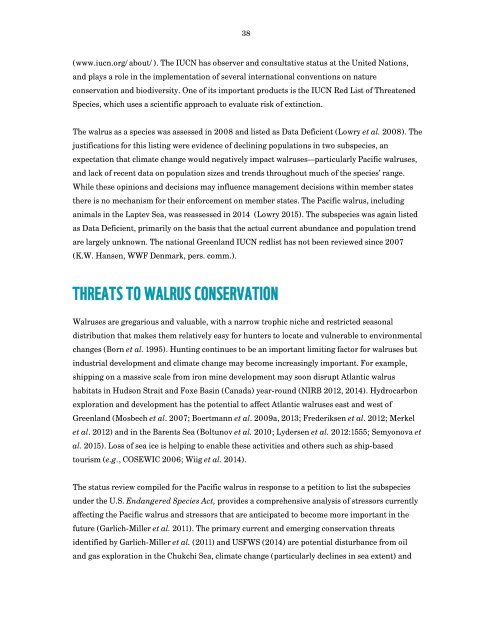The State of Circumpolar Walrus Populations
walrusreport
walrusreport
Create successful ePaper yourself
Turn your PDF publications into a flip-book with our unique Google optimized e-Paper software.
38<br />
(www.iucn.org/about/). <strong>The</strong> IUCN has observer and consultative status at the United Nations,<br />
and plays a role in the implementation <strong>of</strong> several international conventions on nature<br />
conservation and biodiversity. One <strong>of</strong> its important products is the IUCN Red List <strong>of</strong> Threatened<br />
Species, which uses a scientific approach to evaluate risk <strong>of</strong> extinction.<br />
<strong>The</strong> walrus as a species was assessed in 2008 and listed as Data Deficient (Lowry et al. 2008). <strong>The</strong><br />
justifications for this listing were evidence <strong>of</strong> declining populations in two subspecies, an<br />
expectation that climate change would negatively impact walruses—particularly Pacific walruses,<br />
and lack <strong>of</strong> recent data on population sizes and trends throughout much <strong>of</strong> the species’ range.<br />
While these opinions and decisions may influence management decisions within member states<br />
there is no mechanism for their enforcement on member states. <strong>The</strong> Pacific walrus, including<br />
animals in the Laptev Sea, was reassessed in 2014 (Lowry 2015). <strong>The</strong> subspecies was again listed<br />
as Data Deficient, primarily on the basis that the actual current abundance and population trend<br />
are largely unknown. <strong>The</strong> national Greenland IUCN redlist has not been reviewed since 2007<br />
(K.W. Hansen, WWF Denmark, pers. comm.).<br />
THREATS TO WALRUS CONSERVATION<br />
<strong>Walrus</strong>es are gregarious and valuable, with a narrow trophic niche and restricted seasonal<br />
distribution that makes them relatively easy for hunters to locate and vulnerable to environmental<br />
changes (Born et al. 1995). Hunting continues to be an important limiting factor for walruses but<br />
industrial development and climate change may become increasingly important. For example,<br />
shipping on a massive scale from iron mine development may soon disrupt Atlantic walrus<br />
habitats in Hudson Strait and Foxe Basin (Canada) year-round (NIRB 2012, 2014). Hydrocarbon<br />
exploration and development has the potential to affect Atlantic walruses east and west <strong>of</strong><br />
Greenland (Mosbech et al. 2007; Boertmann et al. 2009a, 2013; Frederiksen et al. 2012; Merkel<br />
et al. 2012) and in the Barents Sea (Boltunov et al. 2010; Lydersen et al. 2012:1555; Semyonova et<br />
al. 2015). Loss <strong>of</strong> sea ice is helping to enable these activities and others such as ship-based<br />
tourism (e.g., COSEWIC 2006; Wiig et al. 2014).<br />
<strong>The</strong> status review compiled for the Pacific walrus in response to a petition to list the subspecies<br />
under the U.S. Endangered Species Act, provides a comprehensive analysis <strong>of</strong> stressors currently<br />
affecting the Pacific walrus and stressors that are anticipated to become more important in the<br />
future (Garlich-Miller et al. 2011). <strong>The</strong> primary current and emerging conservation threats<br />
identified by Garlich-Miller et al. (2011) and USFWS (2014) are potential disturbance from oil<br />
and gas exploration in the Chukchi Sea, climate change (particularly declines in sea extent) and


